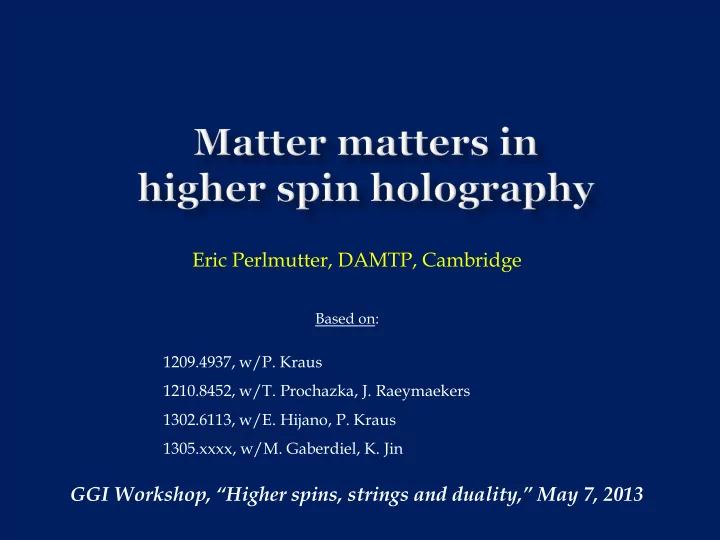

Eric Perlmutter, DAMTP, Cambridge Based on: 1209.4937, w/P. Kraus 1210.8452, w/T. Prochazka, J. Raeymaekers 1302.6113, w/E. Hijano, P. Kraus 1305.xxxx, w/M. Gaberdiel, K. Jin GGI Workshop, “Higher spins, strings and duality,” May 7, 2013
Classical symmetries Spectrum of perturbative states (vacuum descendants; scalar primaries) Spectrum of nonperturbative states (classical geometries, e.g. conical defects and black holes) Modular invariance: relates operators with Δ >>1 to those with Δ ~ O(1) Interactions among these states: correlation functions On the plane, on the torus Many higher order questions Beyond symmetry : we compute, from gravity and CFT: Thermal correlators in the presence of higher spin charge 1. 4-point functions of W N scalar primary operators 2. Highly nontrivial check of structure of interactions in CFT!
Linearizing around flat connections, matter equation is: C = spacetime 0-form containing scalar + derivatives Physical scalar field is identity piece of C: Locally, all is pure gauge: For bulk-boundary propagators, take c to be a highest weight state of hs[ λ ]; then AdS/CFT says [ ] Note: c is a projector! For λ =-N, this is simple:
Starting from BTZ, turn on spin-3 chemical potential, α Infinite tower of nonzero charges “Smoothness” ~ Strong evidence for black hole interpretation despite non-invariant notions of geometry! Probe with a scalar: what does it see? Mixed correlator: nonsingular • CFT L CFT R • Thermal correlator in spin-3 perturbed CFT CFT L CFT R Computed through O( α 2 ) in bulk Match to CFT
Bulk higher spin chemical potential Perturbation of CFT action Deformed correlators: e.g. O( α ) result fixed by 3-pt function, integrated over the torus In fact, O( α ) result is universal at high T; on the plane, where f( λ ) = spin-3 eigenvalue of O. Bulk result is reproduced in CFT via the contour integral Computations done through O( α 2 ); total agreement [See Kewang’s talk]
These calculations do not uniquely select W N minimal models as CFT dual. Now we compute something that does: Scalar primary 4-pt functions at large c and T=0
• W N minimal models: [Gaberdiel, Gopakumar] where • Currents of spin- s=2, 3, …, N, and tower of scalar primaries • Minimal model reps labeled by pair of affine SU(N) highest weights: Consider two very different large c limits at fixed λ : 1. ‘t Hooft limit: 2. “ Semiclassical limit”: Dual to 3d Vasiliev gravity with 0 ≤ λ < 1, Dual to Vasiliev gravity with λ =-N assuming certain operator spectrum c > N-1 implies non-unitarity, e.g. Δ <0 Theory has classical W ∞ [ λ ] symmetry in this limit At linear level, sl(N) Chern-Simons theory + matter
In semiclassical limit, [See Joris ’ talk] Perturbative excitations: 1. (“Single trace”) (“Multi - trace”) Classical backgrounds (“conical defects”): 2. `Conical defect’ = Smooth, asymptotically AdS solution of sl(N,C) Chern-Simons theory with nonzero higher spin charges and contractible spatial cycle [Castro, Gopakumar, Smoothness fixes {Q} to contain Gutperle, precisely the information in an Raeymaekers] Higher spin charges SU(N) Young diagram, viz. that of Λ -
Goals: Compute 4-point functions from bulk Vasiliev theory 1. Match to a boundary calculation, in the semiclassical limit 2. Obvious question: how does one compute 4-pt functions in the bulk without pain? One answer: Choose a simple correlator!
(Defect background) (Perturbative state) W N CORRELATORS FREE SCALARS IN FROM COULOMB λ =-N VASILIEV GAS THEORY
Simple manipulations, simple result … … … [ ] Flat, diagonalizable connection, a z : Computation requires only the matrix element <N|exp(a z z)|1> [ ] Note: det(Vandermonde -1 )
Generally, 4-pt functions not fixed by conformal symmetry Recall some facts about Virasoro: 3-pt functions w/descendants fixed by those of primaries Minimal model representations contain null states, e.g. Null state differential equations hugely constrain correlators: e.g. obeys e.g. G 4 ~ (2,1) hypergeometric functions In W N , more null states needed for closed form answers! We will compute correlators involving φ =(f,0). Many null states! [Fateev, Litvinov; Papadodimas Raju; Chang, Yin]
Compute using Coulomb gas of N-1 free bosons, at finite (N,k) Hard : For 4-pt correlator of φ with generic field O, (Monodromy matrix, function of Dynkin data for O) Easier : Now specify even more: take O = D = (0, Λ ). Only one block contributes! Easiest : Take semiclassical limit: huge simplification!
3d Vasiliev perturbation theory “Witten diagrams”: s + Σ s = Backreaction: Can we form a black hole? The CFT has a global hs[ λ ] symmetry. Can we see this in the bulk, beyond linearized order? Next order questions for the duality: Quantum corrections in 1/c~ G N : many predictions from CFT Black hole formation
Recommend
More recommend